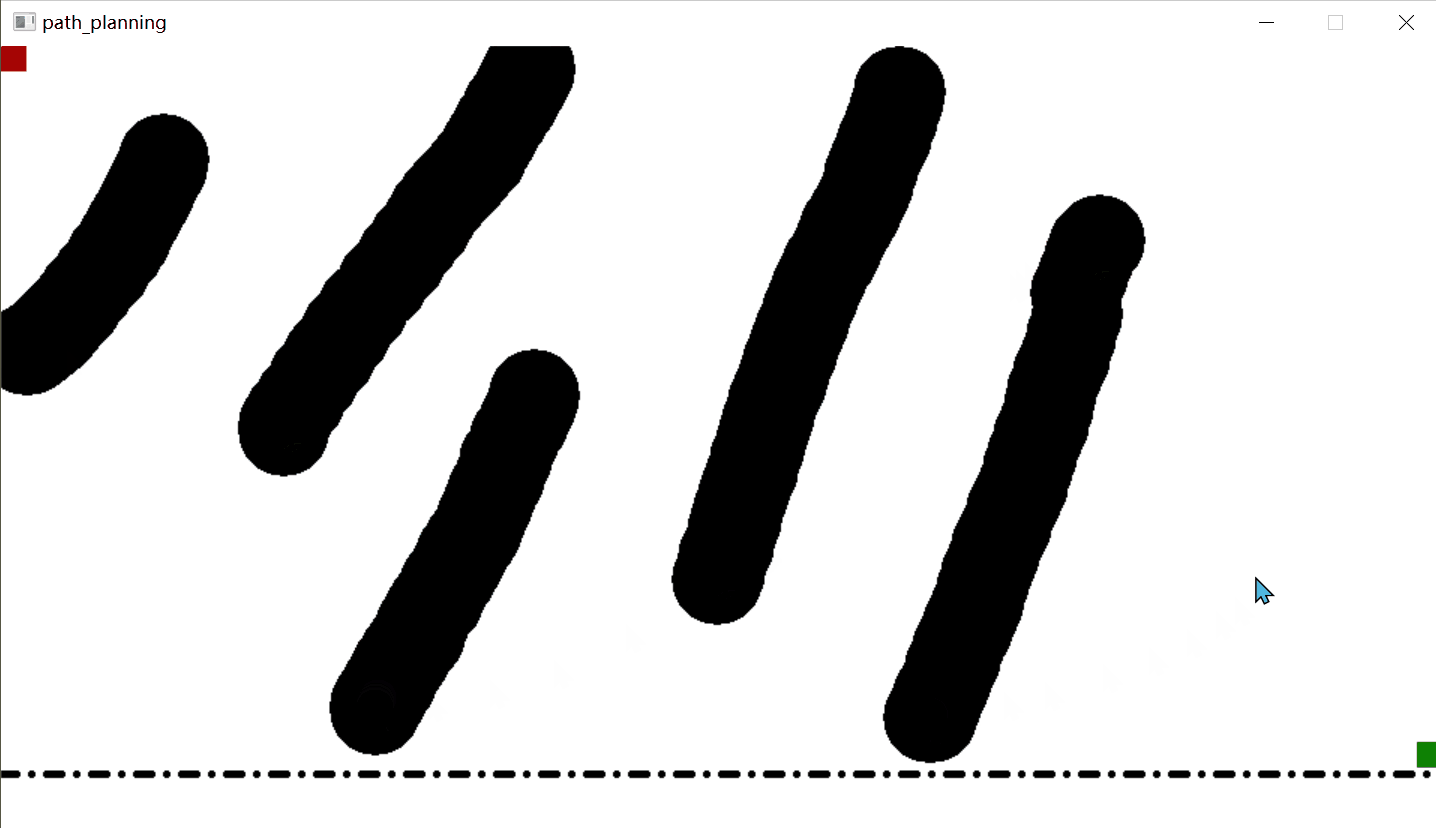写在前面
这篇文章是rrt算法系列的最后一篇文章啦,那么下面一个系列呢,我计划做c++相关语法的学习博客。
为什么要做这么一个c++系列的文章呢?因为做自动驾驶的路径规划的话,实现是必不可少的,那么为了保证算法实现的时间不会太长,高效率的c++肯定是一个不错的选项。
rrt算法效果

file:rrt.cpp
brief:rrt算法实现的主体
author:AIplusX
param:成员变量
return:无
exception:无
note:本系列的前面2篇文章已经进行了详细的介绍,在此不再赘述,请移步浏览
remarks:无
void RRT::rrt_algorithm()
{
srand((unsigned)time(NULL));
setlinecolor(GREEN);
setlinestyle(PS_SOLID, rrt_user_para.rrt_line_width);
int min_dist_random_idx = 0;
Point* search_p = new Point(start->x,start->y);
Point* search_next_p = nullptr;
rrt_path.push_back(search_p);
//testAtan2Radian();
while (1) {
//showParaBelow(end);
delayMs(1);
if (getRandomFloat(0, 1) > rrt_user_para.beta) {
search_p = findMinDistPoint(end);
search_next_p = getRRTNode(search_p);
}
else {
search_next_p = getRandomRRTNode(min_dist_random_idx);
search_p = rrt_path[min_dist_random_idx];
}
if (!isObstacle(search_next_p)) {
search_next_p->pre_point = search_p;
rrt_path.push_back(search_next_p);
line(search_p->x, search_p->y, search_next_p->x, search_next_p->y);
solidcircle(search_next_p->x, search_next_p->y, rrt_user_para.rrt_line_width);
}
else{
delete search_next_p;
}
search_p = findMinDistPoint(end);
if (calcuDist(search_p, end) < rrt_user_para.rrt_edge_len) { break; }
}
getPath(search_p);
}
file:rrt.cpp
brief:ms级别的延时函数
author:AIplusX
param:延时ms数
return:无
exception:无
note:无
remarks:无
void RRT::delayMs(const int& cnt)
{
clock_t start = clock(); while ((clock() - start)<cnt);
}
file:rrt.cpp
brief:判断坐标是否超出了地图的范围
author:AIplusX
param:存储坐标的内存地址
return:布尔型变量
exception:无
note:合法点返回true,不合法点返回false
remarks:无
bool RRT::isLegalPoint(const Point* p)
{
if (p->x >= 0 && p->x < rrt_user_para.rrt_graph_width &&
p->y >= 0 && p->y < rrt_user_para.rrt_graph_height) {
return true;
}
else {
return false;
}
return false;
}
file:rrt.cpp
brief:生成[x,y]范围的浮点数
author:AIplusX
param:范围上界和范围下界
return:随机生成的浮点数
exception:无
note:无
remarks:无
float RRT::getRandomFloat(const float& x, const float& y)
{
return ((x) + (1.0 * rand()) / RAND_MAX * ((y)-(x)));//[x, y]
}
file:rrt.cpp
brief:给定当前节点,往特定方向延伸特定长度
author:AIplusX
param:存储当前节点内存的地址
return:下一坐标节点内存地址
exception:无
note:要考虑新节点和当前节点x值相同的情况,如果x值相同的话直接变换y坐标即可
remarks:无
Point* RRT::getRRTNode(const Point* node)
{
Point* p = new Point();
if (node->x != end->x) {
float theta = atan2((end->x - node->x), (end->y - node->y));
getAtan2Node(p, node, theta);
}
else {
p->x = node->x;
p->y = node->y + rrt_user_para.rrt_edge_len;
}
return p;
}
file:rrt.cpp
brief:atan()函数输出的弧度值转换成图像坐标系下的弧度值
author:AIplusX
param:弧度值的引用
return:无
exception:无
note:直接进行弧度值的引用修改即可,转换方式就是进行画图,然后观察规律
remarks:无
void RRT::changeAngle(float& angle)
{
if (angle < -PI / 2 && angle > -PI) { angle = -3 * PI / 2 - angle; }
else { angle = PI / 2 - angle; }
}
file:rrt.cpp
brief:计算地图中两坐标点之间的欧几里得距离
author:AIplusX
param:两坐标点内存的地址
return:int类型的距离结果
exception:无
note:无
remarks:无
int RRT::calcuDist(const Point* p1, const Point* p2)
{
int dx = abs(p1->x - p2->x);
int dy = abs(p1->y - p2->y);
return int(sqrt(dx * dx + dy * dy));
}
file:rrt.cpp
brief:从终点向前回溯获取可视化路径
author:AIplusX
param:探索路径节点中到终点距离小于阈值的坐标的内存的地址
return:无
exception:无
note:无
remarks:无
void RRT::getPath(const Point* p)
{
setlinecolor(BROWN);
setlinestyle(PS_SOLID, rrt_user_para.rrt_line_width*2);
while (p->pre_point != nullptr) {
line(p->x, p->y, p->pre_point->x, p->pre_point->y);
p = p->pre_point;
}
}
file:rrt.cpp
brief:分别进行相应参数的调试可视化界面
author:AIplusX
param:无
return:无
exception:无
note:这两个函数的实现原理以及效果已在之前文章中进行了讲解,在此不再赘述,请看官移步浏览
remarks:无
void RRT::testAtan2Radian()
{
ExMessage mse;
while (1) {
mse = getmessage(EM_MOUSE);
if (mse.message == WM_LBUTTONDOWN) {
line(480, 240, mse.x, mse.y);
float theta = atan2((mse.x - 480), (mse.y - 240));
changeAngle(theta);
TCHAR s1[5];
_stprintf_s(s1, sizeof(s1), _T("%.4f"), theta);
outtextxy(mse.x, mse.y, s1);
}
}
}
void RRT::showParaBelow(const Point* search_end)
{
ExMessage mse;
while (1) {
mse = getmessage(EM_MOUSE);
wchar_t s1[7];
_stprintf_s(s1, sizeof(s1), _T("(%d,"), mse.x);
outtextxy(100, 500, s1);
wchar_t s2[7];
_stprintf_s(s2, sizeof(s2), _T("%d)"), mse.y);
outtextxy(150, 500, s2);
Point p(mse.x, mse.y);
search_end = getRRTNode(&p);
_stprintf_s(s1, sizeof(s1), _T("(%d,"), search_end->x);
outtextxy(300, 500, s1);
_stprintf_s(s2, sizeof(s2), _T("%d)"), search_end->y);
outtextxy(350, 500, s2);
if (mse.message == WM_LBUTTONDOWN)
line(p.x, p.y, search_end->x, search_end->y);
}
}






评论(0)
您还未登录,请登录后发表或查看评论